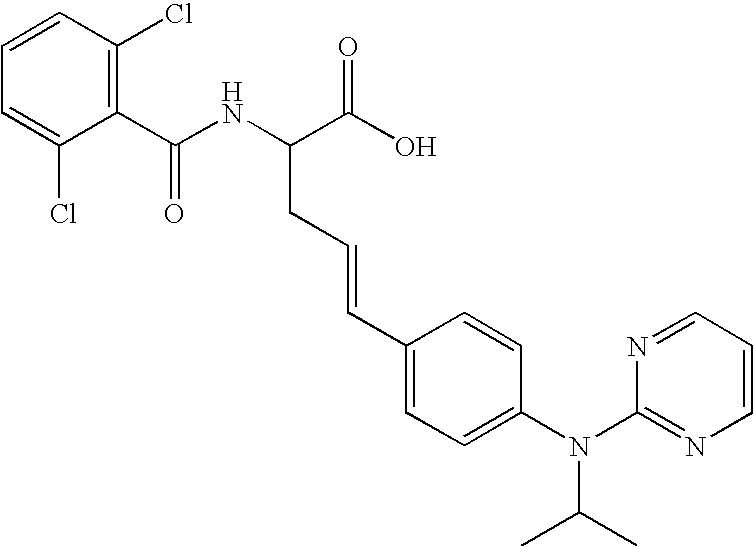Therapeutic or prophylactic agent for multiple sclerosis
a technology for multiple sclerosis and prophylaxis, applied in the direction of immunodeficiency disorder, drug composition, biocide, etc., can solve the problems of repeat recurrence and remission, inability to cure multiple sclerosis, and and achieve excellent oral absorption and in vivo stability. , the effect of high therapeutic or prophylactic
- Summary
- Abstract
- Description
- Claims
- Application Information
AI Technical Summary
Benefits of technology
Problems solved by technology
Method used
Image
Examples
reference example 1
Tetrahydro-4-(4-iodophenyl)-2H-pyran-4-ol
[0170]
[0171]Under an argon atmosphere, a solution of n-butyllithium (2.59M, in hexane) (8.76 ml) was added dropwise to a solution of 1,4-diiodobenzene (7.49 g) in anhydrous THF (50 ml) at −78° C., and the resulting mixture was stirred at −78° C. for 30 minutes. Tetrahydro-4H-pyran-4-one (2.09 ml) was added dropwise thereto and the resulting mixture was stirred at −78° C. for 1.5 hours. After stirring the mixture for another 3 hours at room temperature, water was added, and the resulting mixture was extracted with ethyl acetate. Organic layer was washed once with water and once with saturated brine, and dried over anhydrous sodium sulfate. After removing anhydrous sodium sulfate by filtration, the filtrate was concentrated. The residue was recrystallized from cyclohexane / ethyl acetate mixed solvent to obtain tetrahydro-4-(4-iodophenyl)-2H-pyran-4-ol (4.12 g).
reference example 2
Tetrahydro-4-(4-iodophenyl)-4-methoxy-2H-pyran
[0172]
[0173]Under an argon atmosphere, a solution of tetrahydro-4-(4-iodophenyl)-2H-pyran-4-ol (2.99 g) in anhydrous DMF (10 ml) was added dropwise to a suspension of sodium hydride (60 wt %) (432 mg) in anhydrous DMF (20 ml) at room temperature, and the resulting mixture was stirred at room temperature for 75 minutes. Methyl iodide (0.92 ml) was added dropwise to the reaction solution and the resulting mixture was stirred at room temperature for 8.5 hours. Water was added thereto and the resulting mixture was extracted twice with ethyl acetate. Organic layers were washed with saturated brine, and dried over anhydrous sodium sulfate. After removing anhydrous sodium sulfate by filtration, the filtrate was concentrated. The residue was purified by column chromatography (silica gel, eluent:cyclohexane / ethyl acetate=10 / 1) to obtain tetrahydro-4-(4-iodophenyl)-4-methoxy-2H-pyran (2.87 g). NMR (H1, CDCl3): δ 1.90-2.02 (4H, m), 2.97 (3H, s), 3....
reference example 3
4-Ethoxy-tetrahydro-4-(4-iodophenyl)-2H-pyran
[0174]
[0175]In the same manner as in Reference Example 2, tetrahydro-4-(4-iodophenyl)-2H-pyran-4-ol (302 mg) and iodoethane (0.119 ml) were reacted to obtain 4-ethoxy-tetrahydro-4-(4-iodophenyl)-2H-pyran (269 mg).
PUM
| Property | Measurement | Unit |
|---|---|---|
| temperature | aaaaa | aaaaa |
| temperature | aaaaa | aaaaa |
| temperature | aaaaa | aaaaa |
Abstract
Description
Claims
Application Information
 Login to View More
Login to View More - R&D
- Intellectual Property
- Life Sciences
- Materials
- Tech Scout
- Unparalleled Data Quality
- Higher Quality Content
- 60% Fewer Hallucinations
Browse by: Latest US Patents, China's latest patents, Technical Efficacy Thesaurus, Application Domain, Technology Topic, Popular Technical Reports.
© 2025 PatSnap. All rights reserved.Legal|Privacy policy|Modern Slavery Act Transparency Statement|Sitemap|About US| Contact US: help@patsnap.com



